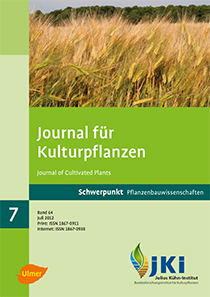Effect of row spacing and cultivar on biomass yield and quality of <em>Sorghum bicolor</em> L. Moench
DOI:
https://doi.org/10.5073/JfK.2012.07.03Keywords:
Sorghum, row spacing, number of tillers, leaf area index, dry matter yield, chemical compositionAbstract
Two years research was conducted to study comprehensively the effect of different row spacing on biomass yield and chemical composition of different sorghum cultivars under field conditions in Germany. Three row spacing (75 cm, 37.5 cm, double rows 75 cm apart with strip rows of 10–15 cm) and two cultivars (Goliath (S. bicolor × S. bicolor), Bovital (S. bicolor × S. sudanense)) were included in 2008, while the same row spacings and five cultivars (Goliath, Bovital, Aron (S. bicolor), Rona 1 (S. bicolor), Akklimat (S. sudanense)) were tested in 2009. In 2008 the leaf area index (LAI) difference between the tested cultivars was significant only after 90 days following germination when Bovital reached higher LAI than Goliath. Among all five tested cultivars in 2009 the lowest LAI was observed for Akklimat at all three measuring dates. The narrow row space of 37.5 cm led to increased LAI while the wider row spacing caused a significant decrease of the number of tillers/m2 in both years. Dry matter yield of sorghum ranged in both experimental years from min. 10.10 t DM/ha (cv. Akklimat 2009) to max. 19.72 t DM/ha (cv. Goliath 2008). Row spacing had no clear effect on the dry matter yield in 2008 whereas in 2009 double rows of 75 cm and narrow row spacing (37.5 cm) led to significantly higher biomass yield than wide row spacing of 75 cm. Effects of row spacing were inverse between years regarding crude protein concentration. Cv. Rona 1 accumulated highest values of sugar concentration (18.7%) and together with cv. Aron lowest values for neutral detergent fiber (NDF), acid detergent fiber (ADF) and acid detergent lignin (ADL) concentration compared with other cultivars.
Published
Issue
Section
License
The content of the journal is licensed under the Creative Commons Attribution 4.0 License. Any user is free to share and adapt (remix, transform, build upon) the content as long as the original publication is attributed (authors, title, year, journal, issue, pages).
The copyright of the published work remains with the authors. The authors grant the Journal of Cultivated Plants, the Julius Kühn-Institut and the OpenAgrar repository the non-exclusive right to distribute and exploit the work.







